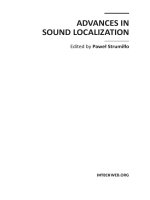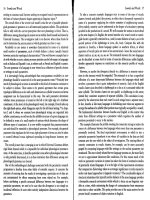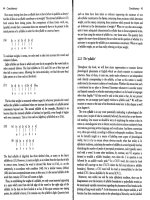LINGUISTICS Sound Structure Part 1: Speech Sounds
Bạn đang xem bản rút gọn của tài liệu. Xem và tải ngay bản đầy đủ của tài liệu tại đây (380.88 KB, 27 trang )
LINGUISTICS
Sound Structure
Part 1: Speech Sounds
2009
Sound Structure of Language
• Many different topics in phonetics and phonology
• Anatomy/physiology etc. of the vocal tract
• The cognitive status of speech and phonology, and
how it interacts with other subsystems of language
• The application in reading. speech technology and
therapy
The Vocal Tract
• The human head seen
in a sagittal view; as if
it had been cut down
the center
• This system has both
survival and speech
functions
Evolutionary History
• The human vocal tract shows a lowering of the
larynx with respect to its position in other primates
• This has consequences for speech, and also the
consequence that humans choke more easily than
other primates do
• While it has been suggested that this is an
evolutionary adaptation that highlights the
importance of speech--the case of the
Neanderthals--it seems to be the case that other
Lowered Larynx: Uniquely
human?
QuickTime™ and a
Cinepak decompressor
are needed to see this picture.
Sounds of Language
• In principle like a saxophone
• consonants have some air constrictions, vowels
don’t: neurolinguistic deficits show differential
difficulties (Caramazza et al. 2000)
• Speech synthesis systems are modeled after the
vocal tract
• 1950’s Rip, mix, and burn: find the acoustic sound
for /k/, /ỉ/, and /t/, and glue them together
• Speech doesn’t have pauses between words--or
consonants and vowels!
When Consonant Meets Vowel
• Front vowel: /i/ (bee), Back vowel: /u/ (boo)
• When consonants meet vowels: say “bee” but
don’t say it!
• Co-articulation
When Consonants Meet Vowels
• same burst of air (dark vertical line)
• different vowels to follow /i/, /a/, /u/ (bee, bot, boo)
• speakers perceive different consonants (pi, ka,
pu)
• no reliable acoustic cues for perception
Bell says ...
• Alexander Graham Bell, the inventor of telephone
• “What we term an “element of speech” may in
reality ... be a combination of positions. The true
elements of articulation, I think, is a constriction or
position of the vocal organs rather than a sound.
Combinations of positions yields new sounds, just
as combinations of chemical elements yield new
substances. Water is a substance of very different
character from either the gases of which it is
formed; and the vowel oo is a sound of very
different character from that of any of its
elementary positions.” (1900)
Bells’ alphabet
Notation for speech sounds
• Linguists use a standardized system of notation
called the International Phonetic Alphabet (IPA) to
represent speech sounds in a consistent fashion
• This uniform system can be used to represent
sounds from any of the world’s languages
Articulators in the Vocal Tract
Organ
Biological function
Linguistic
function
Lungs
breathing
supply airsteam
Vocal
cords
prevent choking
provide vibration
(voicing)
Tongue
yummmm...
articulate sounds
Teeth
eating, hunting
passive articulators
Lips
seal oral cavity
articulate sounds
The Vocal Cords
• The vocal cords are a pair of muscular flaps that
can be brought together to form a seal, or opened
to permit airflow:
Q uickTim e™ and a
Video decom pressor
are needed to see this picture.
Vocal Cords, Cont
When the vocal cords are vibrating to create a
sounds with a pitch, a voiced speech sound
is produced:
Unvoiced
Voiced
s
f
p
k
z
v
b
g
If you hold your hand to your throat, you can
feel vibration for the voiced sounds, as well as
for nasals like [m], [n], and vowels like [a]
Place of Articulation
• Where the sound is made (not an exhaustive list
for English)
• (bi-)labial: with the lips (b, p)
• alveolar: behind the teeth (t, d)
• velar: back of the tongue raised to soft palate
(velum) (k, g)
labial
alveolar
velar
Manner of Articulation
• How the sounds are produced
• Stop: complete closure, with airflow stoppage (b, p)
• Fricative: narrow opening with forced air (s, z, f, v)
• Nasal: air allowed to pass through nose (m, n,
ŋ=ng)
Mini Summary
labial
alveolar
velar
ŋ
In recitation
• You will learn a finer grained dissection of speech
sounds in languages (in particular English)
• You will learn to transcribe speech in terms of IPA
symbols (a chart is included in the reading packet)
Vowels
• A system like that used above is used for vowels as
well:
• High/mid/low: height of tongue in mouth
• Front/central/back: frontness or backness of tongue
in mouth
• Rounded/unrounded: state of the lips during
production of the vowel
• Tense/lax: degree of tenseness in the tongue
English Vowel Chart
IPA Vowel Chart
Notes on the chart
• Many Americans don’t distinguish between caught
and cot: an example of language change
• English also have diphthongs: complex vowels that
combine a vowel with another vowel/semi-vowel
• /aɪ/ (eye)
• /aʊ/ (cow)
• /ɔɪ/ (boy)
Articulatory Sources Online
•
If you're interested in the physical aspects of sounds,
the following is a great website with clear explanations
and animation:
•
•
If you're interested in hearing sounds from many
languages other than English with their appropriate IPA
transcription, go to:
•
•
/>
/>lsandConsonants/
To see more English words with the IPA symbols for
vowels, go to:
•
/>/VowelsandConsonants/course/chapter4/4vowels.html#f
Cognitive Role of Phonetics
• Perception
• Toward phonology
Pa vs. Ba
• b: voiced (/ba/), p: voiceless (/pa/)
• ba: vocal cord vibrates right away, pa has 80 ms
delay
• What happens in between?









